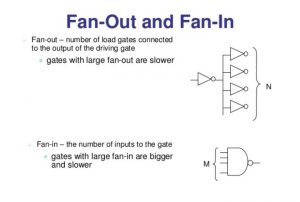Define fan-in, fan-out, CMOS and TTL logic levels
Define fan-in, fan-out, CMOS and TTL logic levels. Fan in and fan out both are the characteristics of digital ICs or we can say that digital integrated circuits. if we talk about ICs then they are the logic networks that are in complete functioning.
The only thing which is needed in digital IC is a power supply or we can say that I/P which means input and O/P which means output.
FAN-IN:
As we mentioned above that it is a characteristic of digital integrated circuits.
Definition:
FAN-IN is defined as the number of maximum inputs that can be accepted by a logic gate.
Also check
Design of Analog to Digital Converter Using CMOS Logic
Explanation:
So we can say that FAN-IN related to the signals of the maximum number of inputs that can be fed into the input equations of logic cell. There should be a limit of number of inputs because if the number of inputs exceeded then the output will be affected and will become undefined or incorrect. Moreover it is specified by the manufacturer and data sheet provides it.
Calculation:
If we want to calculate the FAN-IN then it can be calculated by the:
number of input pins accepted by the gate or available in the gate.
FAN-OUT
As we mentioned above that it is also the characteristic of digital integrated circuits. FAN-OUT is defined as the maximum number of inputs or we can say that maximum number of load that can be connected to the output of the gate and this connection is without degrading the normal operation.
Explanation:
So we can say that FAN-OUT related to the signals of the maximum number of outputs that can be fed into the output equations of logic cell. There should be a limit because exceeding the specified maximum load may cause malfunction it is due to the circuit will not be able to supply the power which is actually demanded.
Calculation:
If we want to calculate the FAN-OUT then it can be calculated by the: amount of current in the output of the gate and the amount of current is required in each input of the gate which is connecting.

Introduction:
First of all we will talk about binary logic which deals with the variables and operations which are the binary. The two values taken by by the variables can be false or true or we can say in term of binary 0 and 1.
There are three basic logical operations:
1-AND
2-OR
3-NOT
Definition:
Binary logic has two levels which is related to binary number i-e 1 and 0 respectively.
These signals are used in Boolean algebra in the designing of digital circuit and also for the analysis of digital circuits.
Levels;
There are two types of logic levels;
1-high logic level
2-low logic level
High logic level:
Two states or levels are existed in term of binary so the logic 1 is called high logic level or state.
Low logic level:
Two states or levels are existed in term of binary so the logic 0 is called low logic level or state.
CMOS ICs:
In case of CMOS ICs the input signals voltages for low logic level is range from 0 to1.5 volts and for the high logic level input signals voltages range from 3.5 to 5 volts.
TTL ICs:
In case of TTL ICs the input signals voltages for low logic level is range from 0 to 0.8 volts according to ground terminal and for high logic level input signals voltages range from 2 to 5 volts.
High Impedance States:
Following are the characteristics of high impedance state:
High impedance state can also be denoted by high-Z or Hi-Z is defined as an state of output signal state which cannot drive the signal.
so we can say that in this state the output is neither high i-e 1 nor low i-e 0. Moreover output is not connected in term of electricity with the circuit.
It is used in buses, if we want to use same wire to transfer more than one signal and also prevent our data.
It is also a point or we can say that a node in a circuit that allows a small amount of current to pass through per unit applied voltage.
Actually high-z circuits have low current and high voltage.
Also read here
https://eevibes.com/computing/introduction-to-computing/what-are-number-systems/
What are the Different Types of Number Systems in Computing?